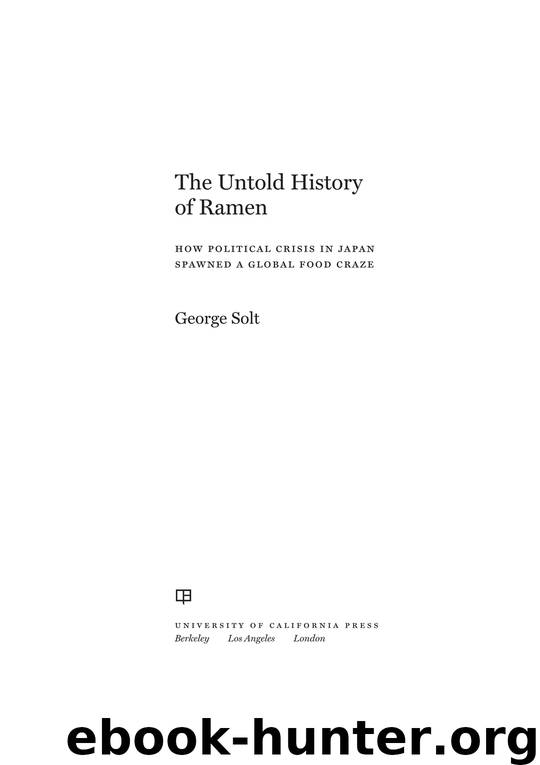The Untold History of Ramen by Solt George

Author:Solt, George
Language: eng
Format: epub
ISBN: 9780520277564
Publisher: University of California Press
HATE IT OR LOVE IT
During the high-growth era there was an explosion of weekly newsmagazines targeting different segments of the population, such as young women, young men, housewives, and adult men. Women’s magazines generally celebrated the convenience and supposed nutrition of instant foods as a manifestation of scientific progress and suggested recipes that would improve on instant ramen, usually through the addition of ingredients. An issue of Young Lady, a weekly magazine targeting working women, for example, notes twenty different ways to make use of instant ramen, such as by adding ketchup, canned tomato soup, garlic, hamburger meat, spaghetti sauce, bacon, or frozen fried rice. After listing the wide range of instant and frozen foods available on the market at the time, the article’s anonymous writer jovially observes, “The world sure has become a lot more convenient.”96 The article also provides a recipe for suiton stew, suggesting how one of the other most widely consumed postwar emergency foods besides Chūka soba was becoming popular among young people in its instant form, to the surprise of those with memories of surviving on it after the war.97
Editorials in magazines targeted at salarymen, on the other hand, often expressed concern about the social changes marked by the explosion of such foods, and particularly about the perceived oversimplification of domestic labor. Although there was no disagreement that the proliferation of household kitchen technologies and scientifically preserved foods in working households was a sign of national economic achievement—an indication that the Japanese were catching up with the often-touted “American” standard of living—the reduction in time required to cook became a matter of controversy for male-targeted magazine writers, who stoked fears that an “American” approach to domestic labor had also been imported into Japan. An article from the literary journal Shōsetsu Kōen nicely illustrates this tension by addressing the advent of frozen food, its impact on gender relations, and the differences between the use of household durables in Japan and the United States.
The anonymous author begins by mentioning that the largest news story of the year was the record sales of washing machines, refrigerators, and televisions. Rather than being a cause of celebration, however, the writer views this situation only as evidence of how relatively poor and inconvenient everyday life in Japan had been until that point. He argues, “In America, ownership of dishwashers (let alone washing machines) is so common that it does not even generate any interest. Now on top of that we have ‘frozen food.’ After being liberated from the duties of cleaning and laundering, housewives are now being freed from even the duty of cooking.”98
After describing for unfamiliar readers what frozen food is and how it is prepared, he continues, “People’s first thought may be that such an item cannot possibly taste good, but that is because they are thinking of the frozen foods they already know, such as hokke or tara [two varieties of cod]. But the frozen foods being sold today [in the United States] have been developed and improved significantly over the last ten years.
Download
This site does not store any files on its server. We only index and link to content provided by other sites. Please contact the content providers to delete copyright contents if any and email us, we'll remove relevant links or contents immediately.
| Culinary Biographies | Essays |
| Food Industry | History |
| Reference |
A Court of Wings and Ruin by Sarah J. Maas(7648)
The Death of the Heart by Elizabeth Bowen(3550)
The Sprouting Book by Ann Wigmore(3543)
Better Homes and Gardens New Cookbook by Better Homes & Gardens(3523)
BraveTart by Stella Parks(3394)
Salt, Fat, Acid, Heat: Mastering the Elements of Good Cooking by Nosrat Samin(3106)
Sauces by James Peterson(3048)
Kitchen confidential by Anthony Bourdain(3006)
The Bread Bible by Rose Levy Beranbaum(3002)
Classic by Mary Berry(2940)
Solo Food by Janneke Vreugdenhil(2927)
Ottolenghi - The Cookbook by Yotam Ottolenghi(2869)
Martha Stewart's Baking Handbook by Martha Stewart(2794)
Day by Elie Wiesel(2716)
Betty Crocker's Good and Easy Cook Book by Betty Crocker(2679)
The Plant Paradox by Dr. Steven R. Gundry M.D(2543)
My Pantry by Alice Waters(2542)
The Kitchen Counter Cooking School by Kathleen Flinn(2484)
Hot Sauce Nation by Denver Nicks(2450)
